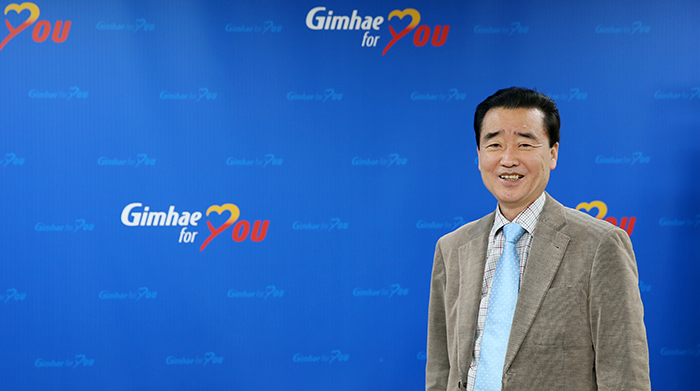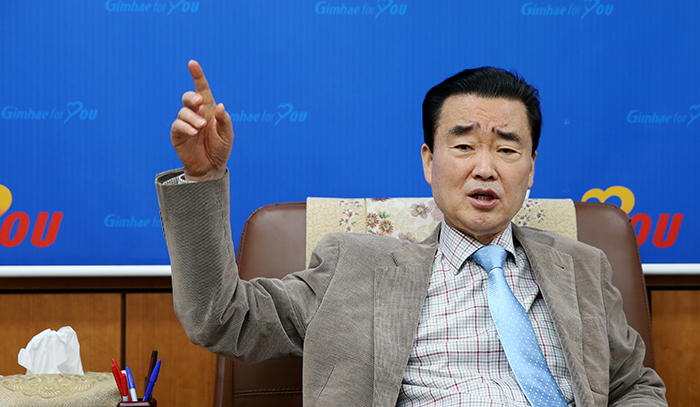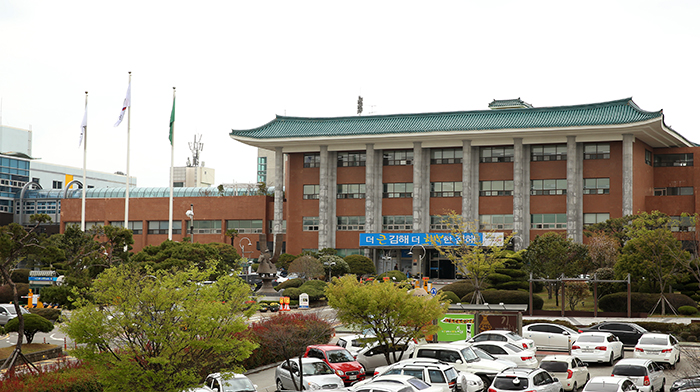
Mayor of Gimhae City Kim Maeng-Gon says that the city inherits the traditions and spirit of the ancient Gaya Confederacy. Gimhae was the capital of the Garakguk Kingdom, also known as the Geumgwan Gaya.
“Gimhae is a kingdom.” This is the definition of the city, according to Mayor Kim Maeng-Gon.
“Gimhae is where King Kim Su-ro (d. 199) built the Garakguk Kingdom in the year 42 and where the values of the Gaya Confederacy (42-532) originated,“ says the mayor, emphasizing that, “This is a city of history and tradition where the culture of ancient Gaya is still alive.”
“The traditions of Gaya, a great iron-making kingdom, have led to the success of about 7,000 firms across Gimhae City. Citizens here have inherited the spirit of Gaya, an ocean-going kingdom symbolized by challenges and innovation,” he added.
A businessman-turned-mayor, Kim formerly served as a national representative. He was elected as the 17th mayor of the city in 2010 and was then re-elected to the post last year. He has been reflecting on the spirit of challenges and innovation in the management of city affairs. The city's debt was reduced by more than KRW 12.97 billion last year, half of the KRW 27.15 billion of debt that existed when Kim first took office. The city has transformed itself into an exemplary model of financial management.
Regarding know-how on how to steadily attract business and investment, and how to increase a city's population, the mayor says, “Commitment to a goal matters most. We need to have an accurate awareness of the local government and effectively manage the city’s budget. This is the most important thing.”
“It is important to see the big picture when managing government affairs. We need to keep injecting or increasing the budget in certain areas, if considered necessary. At the same time, we need to take bold action by removing unnecessary projects which were considered important in the past, despite objections from other parties which may have vested interests.”
Pursuing change and development, the Gimhae mayor has also been making efforts to preserve and restore the area's history and heritage.
“[Overseas] people might think of the Joseon Dynasty when thinking about Korean history. However, the Gaya Confederacy existed long before Joseon. The kingdom began the globalization of Korea through trade, just like today’s FTAs. The Gimhae Gaya Theme Park has a restored Gaya royal palace. People can experience the heritage and traditions of Garakguk, a globalized kingdom that existed on the Korean Peninsula some 2,000 years ago,” said Mayor Kim, hoping that many people visit the theme park to learn more about Gaya.

Mayor Kim talks about the Gimhae Gaya Theme Park, scheduled to open this May.
Korea.net sat down with him to talk about Gimhae, a city of development and innovation.
- The Gimhae Gaya Theme Park is soon to open, part of Gimhae’s goal of becoming a city of elegance and high culture. What did you concentrate on most when creating the theme park?
The Gimhae Gaya Theme Park is a cultural complex focusing on providing opportunities for people to experience something unique. The theme park is composed of various facilities, including a restored Gaya royal palace, performance venues for musicals, a playground for children, a village where visitors can experience what it was like to be an ancient warrior and a campground.
This place is not just designed for viewing. It is an experience-centered, hands-on theme park for families. Visitors can watch, listen, feel and taste life in ancient Gaya. They will also be able to appreciate a musical based on the story of King Kim Su-ro and his wife, Queen Heo, which will be staged everyday at the performance hall.
- Gimhae is home to the history of the Garakguk Kingdom, also known as the Geumgwan Gaya, founded by King Kim Su-ro. What efforts do you make to promote Gayan cultural heritage, including actions to add Gaya royal tombs to UNESCO's list of world heritage items?
We have not only applied for the Gaya royal tombs to be inscribed on the UNESCO World Heritage items list, but Gimhae has also been hosting programs like international academic seminars on the history of Gaya and field trips to ancient Gaya historic sites.
The Gaya burial mounds of Gimhae, including the burial sites in Daeseong-dong, in the center of the city, are perfectly preserved. In March this year, they were added to Korea’s Tentative List of UNESCO World Heritage items. Along with the Haman Malisan Tumuli and the Goryeong Daegaya Tumuli, we have been steadily preparing for our application, together with UNESCO. An international academic conference on Gayan history, held during the Gaya Culture Festival, marks its 21st anniversary this year. We have been promoting the excellence and exclusiveness of Gayan culture based on the accumulated outcome of the academic research.
- The Gaya Culture Festival marks its 21st anniversary this year. This festival has a relatively longer history than other local festivals. What is its secret to success?
The Gaya Culture Festival opens every year. The overall program, including the structure of the festival venue, performances, exhibits and activities, are all based on academic research into Gaya history. It also includes the beautiful love story of King Kim Su-ro and Queen Heo. The festival starts with a chunhyangdaeje, a big rite held to honor King Kim Su-ro in the spring. It wins lasting popularity, thanks to its interesting programs and to the many things to enjoy.
- As the ancient capital of Garakguk and the home of the Gaya Culture Festival, Gimhae City is expecting to attract 10 million annual visitors this year. What efforts have the city undertaken to achieve this goal?
Gimhae is like a huge history museum. Last year, approximately 7.6 million people visited the city. To minimize inconveniences, we opened a tourist hotel of superior quality last year. This February, we opened the Gimhae Intercity Bus Terminal, equipped with the state-of-the-art technology. Targeting families, the Gimhae Gaya Theme Park is preparing to open soon. In 2016, we will open a, “wine tunnel & rail bike,” experience program.

Gimhae City expects to see more than 10 million annual visitors this year. The above photo shows Gimhae City Hall.
- We are aware that Gimhae City has been actively engaging in exchanges with local government organizations and groups from around the world in order to meet the needs of the people in an era of globalization. Can you tell us about your efforts in this regard?
Gimhae City has forged sister-city relationships with Munakata Prefecture in Fukuoka, in Japan, with Salem, the Oregon capital in the U.S., the Vietnamese city of Bienhoa in Dongnai Province, and with Ayodhya City, in Uttar Pradesh, India. We are engaged in exchanges with these cities across many sectors, including administration, the arts, sports, the economy and education. Gimhae’s steady exchanges with its sister cities is an investment in the future, which creates a foundation and the environment for the city, its citizens, its organizations and other groups to grow, so that they can penetrate overseas markets and find success globally.
- Over the past six years, the city has focused on striving to attract foreign direct investment. You also came up with some noticeable outcomes. Can you explain what the charms of Gimhae City are for foreign direct investors?
Gimhae City has built a network of international transportation links which involves Gimhae International Airport, Busan Port, Masan Port and the Busan New Port. Thanks to our location, about 150 new firms move to Gimhae every year, which gives us about 7,000 companies that operate in the city.
In the Science Park, a specialized industrial complex for non-Korean firms, about 20 companies, including Japan’s Kuroda Electric, will move in. A 2.4 million-pyeong (1 pyeong = 3.3 square meters) high-tech industrial complex is being built. This complex includes the Golden Root, Daedong and Gimhae Techno Valley complexes.
- Gimhae City has the largest number of non-Koreans anywhere in Gyeongsangnam-do (South Gyeongsang Province). Why is that? Can you explain Gimihae’s measures to help them fit in to society here?
As of the end of February 2015, a total of 17,929 non-Koreans resided in Gimhae City. The steadily-increasing population of non-Korean residents is due to the increasing number of new companies which are moving to Gimhae and due to the increase in international marriages.
To help them stably adapt to their lives in the city, we provide Korean language education, computer use, translation and interpretation services and consultations through related organizations, such as the Gimhae Multicultural Family Support Center and the Gimhae Foreign-Workers Center. In every odd-numbered month, non-Korean residents can receive a free medical check-up at the Gimhae Central Hospital. We have also been running various cultural events and experience programs for them so that they can more easily learn more about Korean society.
- Gimhae City has also been making remarkable efforts to protect children and toward welfare for the elderly. We assume there must be many difficulties in funding or upgrading the quality of such welfare. How are you coping with that?
Gimhae City hasn't spared any support in advancing the human rights and welfare of children here. A first in South Gyeongsang Province, we opened the Gimhae Children Protection Center on March 27 this year.
Gimhae has been increasing its senior citizen welfare budget every year. We have taken various measures to enhance the welfare of our seniors, such as support for senior citizens who live alone, building and renovating senior centers and supporting life-long education centers for the elderly. The best welfare for them is to be provided with a good job. We will continue to expand investment in order to boost the elderly's participation in society and to build a strong welfare infrastructure.
Article by Jeon Han, Yoon Sojung
Photos: Jeon Han
Korea.net Staff Writers
hanjeon@korea.kr